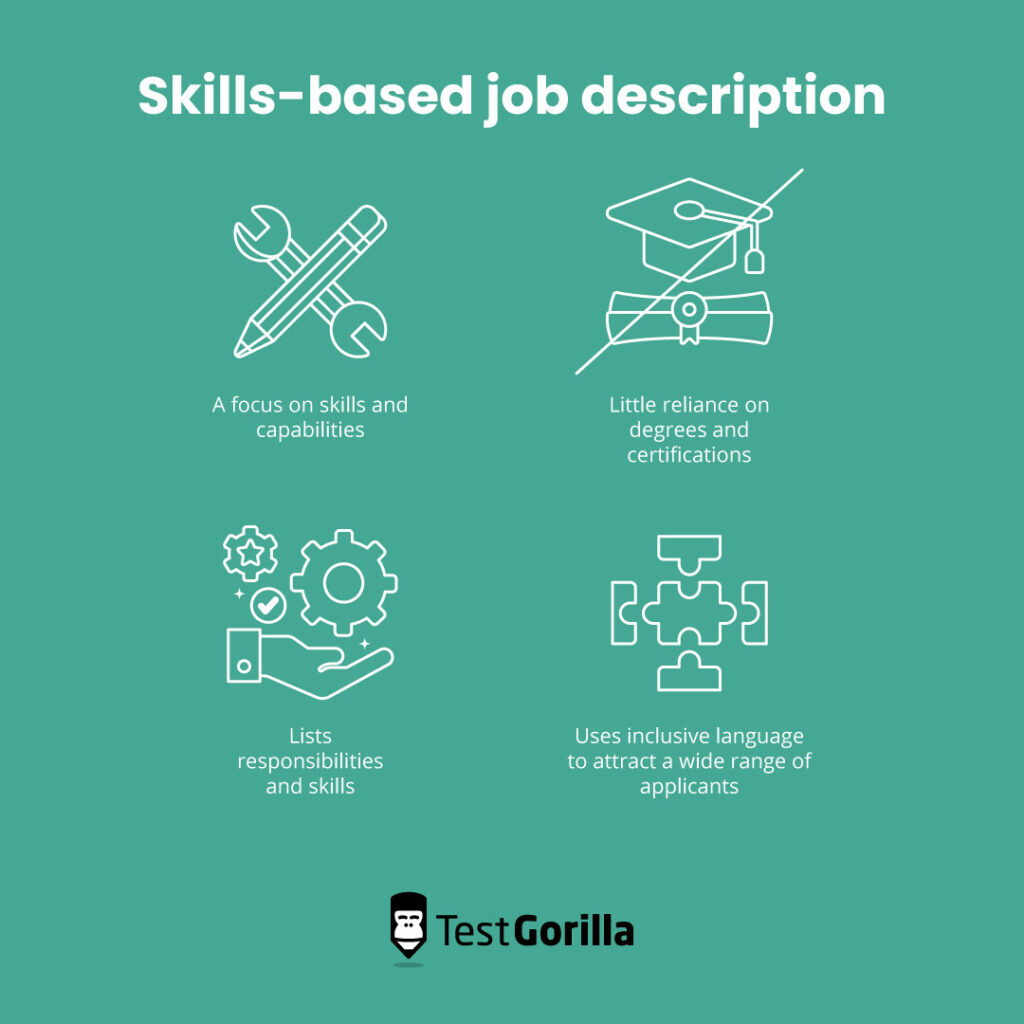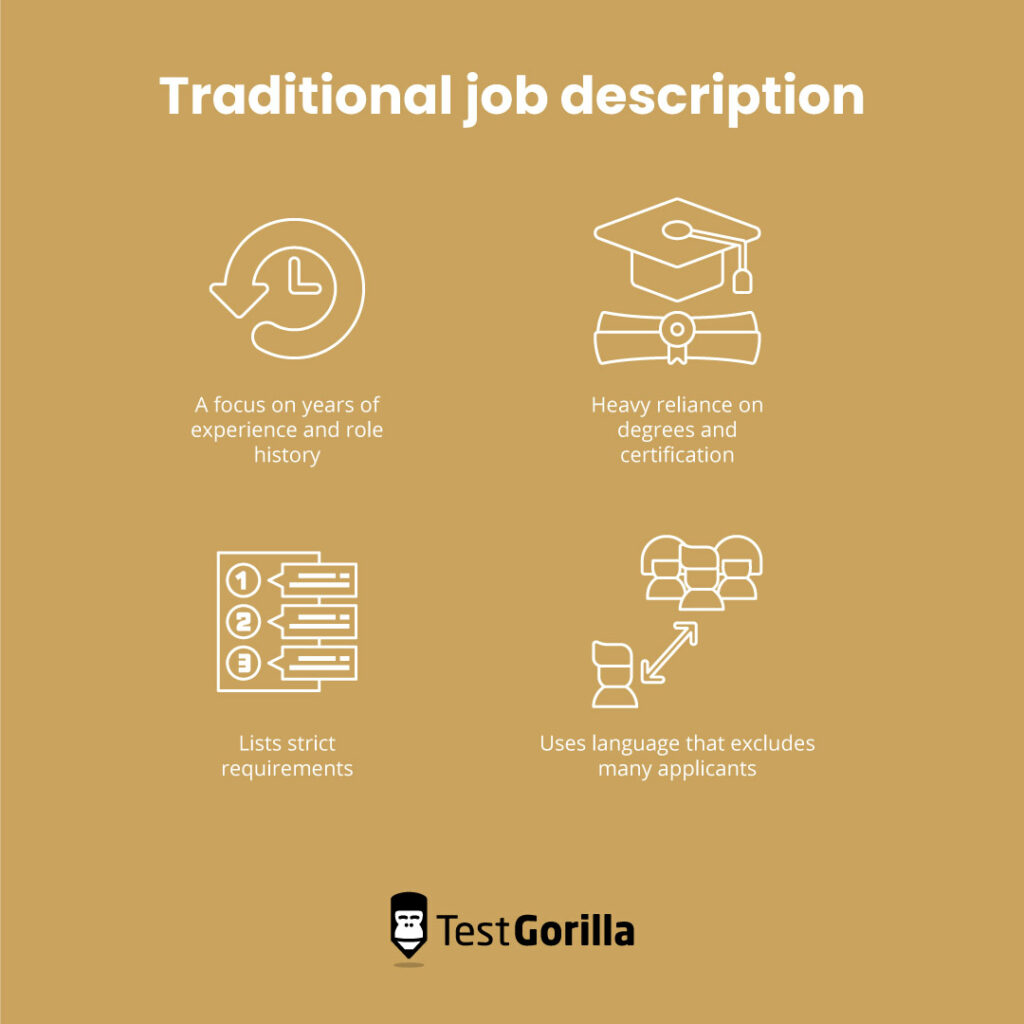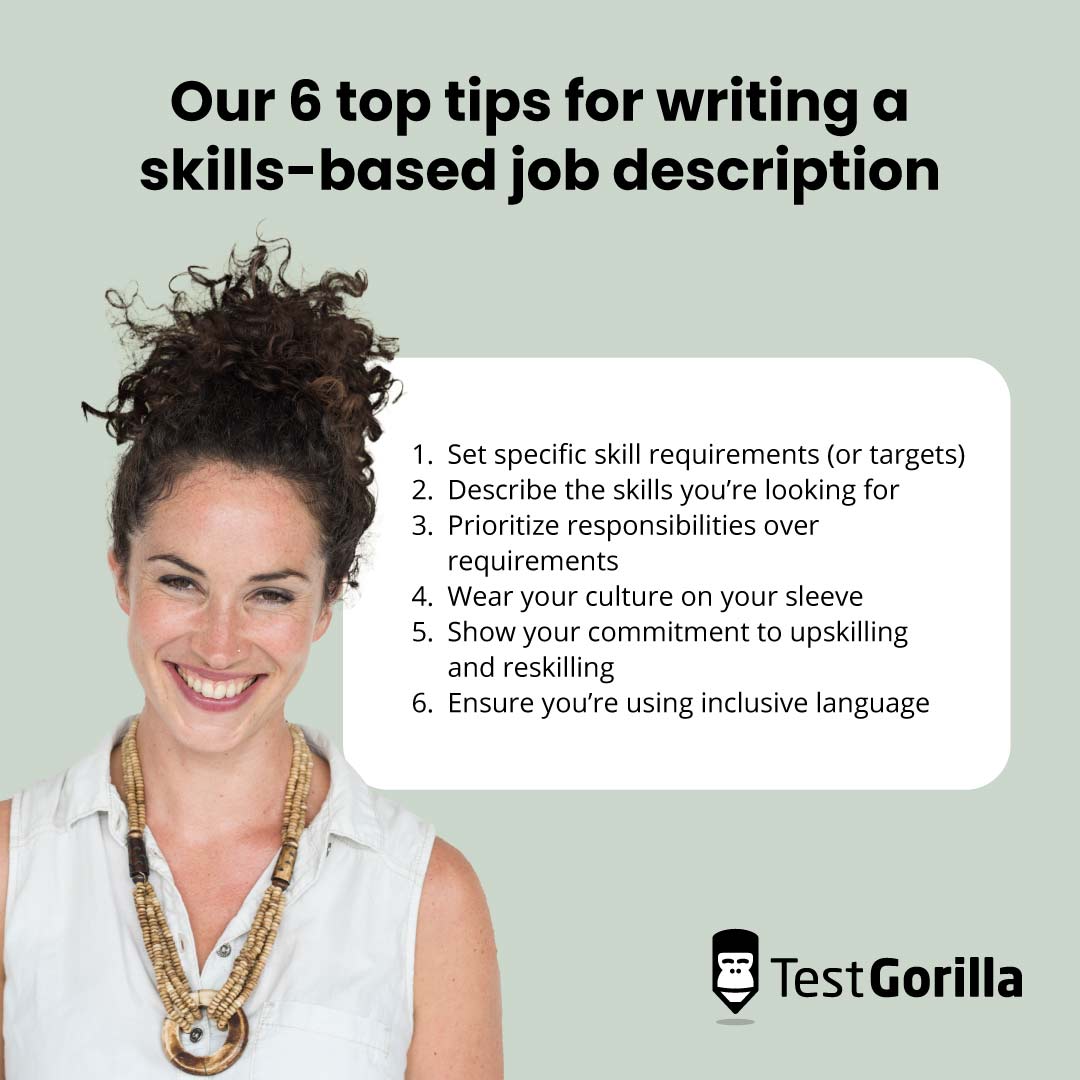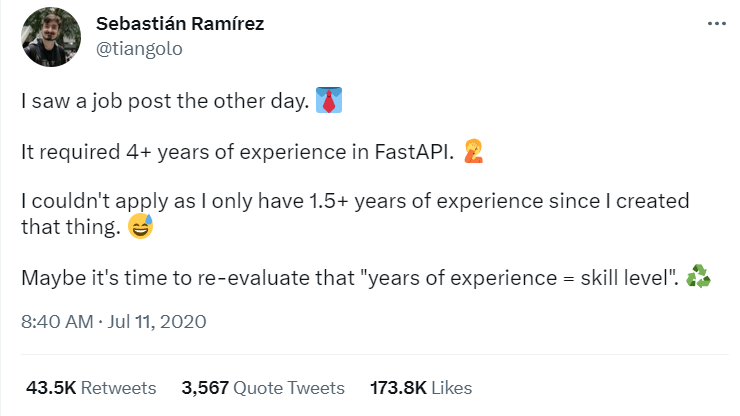How to prepare job descriptions for a skills-based hiring approach
Nearly every role starts with a good job description. It’s there to display job responsibilities, cover important skills, and attract the right applicants.
Job descriptions prepare candidates for success and reduce the chance of mis-hires. But how are they different when you take a skills-based approach to hiring?
Skills-based job descriptions focus on skills and responsibilities, avoid listing unnecessary degree requirements, and promote learning and upskilling.
Skills-based hiring is the future of hiring, with 76% of companies using it. If you’re considering making the switch from traditional to skills-based hiring, then you need to know how to write skills-based job descriptions.
Let’s discuss what differentiates a skills-based job description, how they attract better candidates, and our top tips for writing a job description focused on skills.
As a bonus, we’ve included a detailed skills-based job description template at the end of the article.
Table of contents
- How is a skills-based job description different from a traditional one?
- How does a skills-based job description help you attract better candidates?
- Our 6 top tips for writing a skills-based job description
- How do you test for the key skills before moving on to interviews?
- An example skills-based job description template
How is a skills-based job description different from a traditional one?
We’re all pretty familiar with traditional job descriptions and job specifications. They list out the “typical” requirements for the role, including relevant industry experience and the right education.
However, they can be problematic. Not all great candidates have a relevant work history and many lack the “expected” educational background, even when the relevant skills can be obtained through alternative paths. This means traditional job descriptions alone could be narrowing your talent pool.
Stop listing unnecessary requirements in your job descriptions to access a broader audience and attract top talent. This is the aim of a skills-based job description.
A skills-based job description prioritizes and focuses on skills, rather than asking for degrees and years of experience. For example, a UX architect job description may ask for someone with prototyping skills, UX design experience, and user research and usability testing proficiency.
Skills-based job descriptions put skills and capabilities front and center and remove unnecessary obstacles that could discourage excellent candidates from applying.
Inclusivity is an important aspect, but attracting nontraditional candidates isn’t the only perk to skills-based job descriptions. They’re also what modern candidates want.
According to TestGorilla’s State of Skills-Based Hiring 2023, 56% of candidates prefer a skills-based hiring process.
Let’s see why candidates might love it by looking at a comparison between a skills-based hiring job description and a traditional job description:
Skills-based job description | Traditional job description |
A focus on skills and capabilities | A focus on years of experience and role history |
Little reliance on degrees and certifications | Heavy reliance on degrees and certification |
Lists responsibilities and skills | Lists strict requirements |
Uses inclusive language to attract a wide range of applicants | Uses language that excludes many applicants (either consciously or unconsciously) |
Skills-based job descriptions help you keep your desired results at the forefront of the candidate’s mind.
It isn’t surprising that candidates want a focus on capabilities and skills. This practice tells applicants exactly what’s expected from them and what the role requires.
For example, listing a skill like “The ability to discuss new strategies with clients regularly” gives a much clearer picture than simply asking for “4 years experience in content strategy.”
Candidates want the clarity and transparency that skills-based hiring offers. It leads to a better candidate experience. For more information on this subject, read our article on skills-based hiring from a candidate’s perspective.
It’s important to note that you still have to keep certifications where they’re required, such as in healthcare, engineering, and legal positions.
You can still use skills-based hiring for these positions, but we recommend you use qualifying questions to verify they meet the right law-abiding criteria before moving on to applications and skills testing. You can learn more about qualifying questions on our blog on the 8 best practices for screening applicants.
How does a skills-based job description help you attract better candidates?
Let’s get right to the most important point: Skills-based job descriptions appeal to a broader, more diverse talent pool.
Skills-based hiring tosses out the need for resumes, expanding your reach to thousands of stellar candidates with untraditional backgrounds.
Increasingly more employers are seeing the immense value in STARs, which stands for “skilled through alternative routes.”
These candidates have highly desirable skills and capabilities but won’t show up on a traditional radar because they’ve acquired their skills through life experience, work history, hobbies, and volunteering, but not formal education.
A skills-based job description doesn’t rely on traditional requirements, making your job openings more accessible to underrepresented groups who have a much lower rate of possessing four-year degrees.
Here’s a look at the amount of Americans who don’t hold a four-year degree:
60% of American workers over the age of 25
This means that implementing skills-based job descriptions is an excellent way to drive your DEI initiatives and hire more diverse talent. Increasing workplace diversity has been shown to increase productivity and innovation, as well as improve financial performance.[1]
Skills-based job descriptions don’t only attract more diverse applicants; they attract candidates with the right skills. By clarifying responsibilities and focusing on skills, your job description is likely to catch the eye of an applicant with the matching skillset (rather than an applicant who simply holds a degree in a certain subject).
The best insights on HR and recruitment, delivered to your inbox.
Biweekly updates. No spam. Unsubscribe any time.
Our 6 top tips for writing a skills-based job description
So, what do you need to include in this job description?
A skills-based job description should put responsibilities and skills front and center, display your company culture, and outline any opportunities for learning and development.
Let’s take a look at our top strategies for writing the perfect skills-based job description.
Tip | Description |
Set specific skill requirements | Consider the role’s essential competencies |
Choose about five competencies and skills | |
Describe the skills you’re looking for | Explain how each skill is used in the role |
Avoid specific terminology to widen your talent pool | |
Prioritize responsibilities over requirements | Focus on responsibilities and make them front and center |
Remove years of experience | |
Remove unnecessary certifications | |
Wear your culture on your sleeve | Show candidates what makes your culture unique |
Attract like-minded, yet diverse individuals | |
Show your commitment to upskilling and reskilling | List preferred skills that candidates don’t need from day one |
Promote learning and upskilling positively | |
Ensure you’re using inclusive language | Review your job descriptions for coded language |
Reach a more diverse audience by using inclusive terms |
1. Set specific skill requirements (or targets)
Setting specific skill requirements or desirable targets is essential to get the right candidates to apply.
First, consider the required occupational competencies. These are the technical skills required from day 1, while other abilities can be learned and upskilled with time (more on that later).
A designer, for example, needs to know how to use image-editing software, and a writer needs research and grammar skills. These are key competencies.
Which competencies can a candidate not learn on the job? Which skills do they need from day one? These competencies are your required skills.
We recommend around five required competencies and skills.
You can discover these competencies by asking yourself a few questions:
How is this role important to the company?
What are its day-to-day responsibilities and key skills?
What are our expectations?
Which relevant soft skills does the candidate need?
Prioritizing soft skills in a job description is important. They’re not only essential for some roles, such as communication for a project manager, but they’re also valuable transferable skills.
Transferable skills are key to facilitating industry or career switching. Check out our full blog on transferable skills for more information.
2. Describe the skills you’re looking for
Once you know what your role needs, you need to describe them well enough to convey your needs to applicants.
Focusing on skills and describing them adequately is the key to a good skills-based job description and ensures you get a great hire.
When a candidate can clearly understand what the role requires, they know whether or not they have the needed skills. Then, they’re much more likely to apply.
Here are a few tips to help you describe your required skills:
Explain how the skill is used in the role
Describe how the skill is used daily and weekly
Use generic terminology as often as possible
You risk narrowing your talent pool if your terminology is too specific, but generic terms widen your potential audience. For example, instead of asking for proficiency with Monday.com, ask for proficiency with project management tools and software. Applicants who have this proficiency will be quick to learn how to use Monday.com if they have no prior experience with it.
3. Prioritize responsibilities over requirements
One of the most important parts of a skills-based job description is putting responsibilities center stage and getting rid of strict requirements.
Be mindful of which skills require certifications and which don’t. Sometimes certifications are necessary, like for certain medical or legal roles, but other “credentials” can be just barriers between you and top talent.
For example, coding and content writing are two fields filled with candidates without certifications. You don’t need a literature degree to write great content, or a computer science degree to be a skilled programmer.
We recommend reducing reliance on certain requirements and completely eliminating some of them, such as years of experience.
A certain number of years of experience doesn’t accurately represent someone’s skills and it can lead to unfortunate outcomes, both minimum and maximum:
Maximum years of experience requirement: This puts a limit on the number of older candidates available to you and getting rid of it is a positive step to eliminating age discrimination in hiring.
Minimum years of experience requirement: This excludes thousands of candidates who received their skills from an alternate source or those who are switching industries.
Asking for specific years of experience can also get ridiculous. Take this Tweet from Sebastián Ramírez, the creator of FastAPI.
Sebastián found a job ad requiring over four years of experience using FastAPI – which means even he couldn’t apply for it because he created the program only a year and a half ago.
This is closely tied to degree inflation, which is another trend that is narrowing your candidate pool by asking for four-year degrees where they shouldn’t be required.
Prioritizing responsibilities over requirements also keeps job descriptions concise and relevant, informing candidates on exactly what a role needs.
Relying solely on experience could land you in an awkward situation. For example, a hiring manager at a marketing agency might hire a senior editor only to discover that the skills required for the same position at a television station are vastly different from the skills of a senior editor at a marketing agency. To read this story and more, check out our 5 stories from resume recruiting hell.
4. Wear your culture on your sleeve
Company culture is an important component of a skills-based job description for a number of reasons. By adding a section about your culture, you can:
Let applicants know what kind of place your company is
Find candidates with culture-add potential
Cultivate a better work environment
Reduce mis-hires
There’s a reason why company culture is one of the top employee job satisfaction factors. Candidates want to work for a company that shares their values – a place they feel comfortable working.
We recommend going for culture add over culture fit. “Culture add” is the practice where you don’t aim for a perfect cultural fit, but instead weave diverse perspectives into a growing open-minded team.
You can facilitate this process by using our Culture Add test once the application stage is over and you’re assessing applicants with skills tests.
Avoid generic terms like “we’re a family” or “we focus on innovation” since these are so overused that they won’t accurately convey your culture.
Try diving into the specific things that make your company unique. Describe your inclusive hiring efforts, display your skills-based practices, or focus on your transparency by opting for salary transparency.
If you’d like to dive into this and get some solid examples, read our guide on how to describe your company culture.
5. Show your commitment to upskilling and reskilling
Skills-based hiring is all about continuous improvement, so a good skills-based job description should show applicants your dedication to upskilling and reskilling.
We recommend adding a section in your job description for “preferred skills.” These are skills that the job requires but aren’t strictly required from day one and can be learned as the employee works.
For example, in a product designer job description, preferred skills could be proficiency in software like Adobe Illustrator or knowledge of front-end development languages like JavaScript to collaborate with developers.
You can also phrase this as “You will learn how to…” This boosts the positivity of the language and emphasizes the learning aspect. For example:
“You will learn how to fluidly use CRM software.”
“You will learn key managerial skills with the potential to grow.”
This attitude nurtures a healthy mindset where employees are eager to develop and are more likely to stay longer.
According to the 2021 survey by Monster.com (the employee marketplace, not the energy drink), 45% of employees would be more likely to stay with a company if it invested in their professional development.
Opening the door to upskilling also widens your talent pool because you aren’t shooting for an unrealistic purple squirrel – you’re getting candidates who have the necessary skills and providing them with training for the preferred ones.
6. Ensure you’re using inclusive language
If you want to broaden your talent pool and reach stellar candidates from all demographics, language matters.
Certain words and phrases unconsciously show bias towards certain candidates. This is called “coded language.”
For example, age-coded language might look like “digital native” or “youthful,” which automatically excludes thousands of older workers.
Gender-coded language actively discourages women from applying for jobs. Words like “dominant” or “competitive” have been shown to have a male bias, which makes female applicants uncomfortable.
Taking the time to review your language for unconscious bias can expand your talent pool and improve your inclusivity efforts.
If you want to take a deeper look at inclusive terminology, check out our DE&I glossary.
How do you test for the key skills before moving on to interviews?
You’ve listed the necessary skills, and you’ve tossed out resumes – so how do you determine the candidate’s capabilities?
Pre-employment skills testing objectively evaluates your candidates and gives you real data on their capabilities.
Skills tests help hiring managers assess and prove an applicant’s skills so that they don’t need to ask for work history or college degrees.
Here’s an example assessment, made of five different tests, for a content writer:
SEO Copywriting test
Reading Comprehension test
Time Management test
Critical Thinking test
Culture Add test
All of these tests and more are available in our test library.
After the candidate is finished taking their assessment, the hiring manager can review the results. Their skills are displayed through clear percentages, which is something that submitted resumes can’t do.
TestGorilla uses a scoring benchmark tool, which shows how your candidates scored relative to other candidates who have taken the same tests.
You simply sort your candidates by your predetermined criteria and then invite the best to interviews. We’d recommend structured interviews.
An example skills-based job description template
So you have something tangible to start working with, check out our example skills-based job description template.
We’ve filled in some of the fields for a content writing role, just for clarity, but you can simply delete them and write in your own.
Example template
[Insert the job title]
Reports to: [Insert managers/supervisors the role reports to]
[Insert your company description]
[Insert the role description]
A description of responsibilities, activities, and what a typical day in the role involves
Responsibilities
Develop and pitch creative ideas
Deliver high-quality content
Influence content strategy
Required technical skills
Writing
Researching
SEO and keyword optimization
Fluent English language proficiency
Ability to work with word processing software
Required soft skills
Communication skills
Attention to detail
Critical thinking
Time management
Preferred skills
Linguistics
Negotiation
Coordination
Other relevant information
Location
Salary
Full-time
Travel
Benefits
This is a solid start to begin your skills-based hiring efforts. For more information, read our full blog on how to write great job descriptions. Want to see a specific example? Check out our guide to writing an information architect job description, which includes a template.
A solid skills-based job description should emphasize responsibilities, skills, and culture.
Traditional job descriptions relied heavily on history, experience, and degrees only because we had no other way to assess capability.
Now we have skills tests, which enable us to rely on what truly matters – technical and soft skills.
What’s the next step in the skills-based hiring process? Assessing applicants with skills tests. For more information, read our guide to pre-employment skills testing.
To take a look at our skills tests, browse our test library.
Sources
Lorenzo, Rocío; Voigt, Nicole; Tsusaka, Miki; Krentz, Matt; Abouzahr, Katie. (January 23, 2018). “How Diverse Leadership Teams Boost Innovation”. BCG. Retrieved February 27, 2023. https://www.bcg.com/publications/2018/how-diverse-leadership-teams-boost-innovation
You've scrolled this far
Why not try TestGorilla for free, and see what happens when you put skills first.























